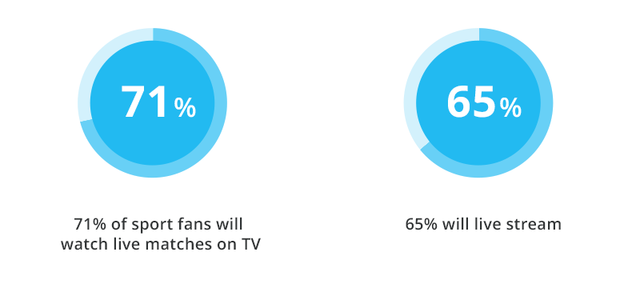Tellyo central to Ascot Racecourse fan engagement and commercial strategy
Ascot Racecourse is synonymous with global sports fans, bringing exciting horse racing meetings to thousands of spectators each year with millions more watching worldwide.
Central to their fan engagement and commercial strategy is their usage of Tellyo’s intuitive broadcast quality streaming, clipping, editing, publishing and distribution toolset.
Tellyo and Ascot Racecourse have worked together since 2017, building a trusting relationship that has enabled the Ascot Racecourse team to constantly innovate, attract commercial partnerships with their content and out perform their competitors across their digital ecosphere.
Ahead of each meeting, Rhys Hayward, the Digital Editor at Ascot Racecourse, and his team upload branded bumpers to Tellyo Pro.
With the live broadcast feed quick and easy to ingest into the system, the digital team watch the racing unfold. In real-time, the team live clip the final two furlongs of each race, where it is won and lost, and prepare the clip for distribution by adding their own graphics within Tellyo Pro.
Once the team are happy, the pre-prepared branded bumpers, showcasing Ascot’s sponsors and partners, automatically top and tail each specific piece of content to streamline their workflow.
Distributed to Twitter and Facebook within moments of the race finish, fans around the world can watch back the crucial moments and gain immediate insight.
The Ascot team successfully used Tellyo during the first part of 2021, including Royal Ascot. This helped result in a record performance for Ascot’s social channels, including 6.3m video views across the week.

After the summer break, the Autumn/Winter season officially began on Friday 1 October with a two-day Flat Meeting where the team continued their use of Tellyo.
The season continues through November with Jumps and into December with the Howden Christmas Racing Weekend.
Tellyo is at the heart of the digital teams plans and on their usage, Digital Editor, Hayward, commented, “As we continue to grow our digital audiences globally, being able to quickly share our rights across social media and beyond remains central to this.
“As we return to full crowds for 2022, Tellyo will continue to play a big role in our race day content delivery.”
Richard Collins, Chief Executive Officer at Tellyo, commented, “Ascot is a famed race track with a loyal and highly engaged global fanbase who want to engage with high quality content.
“The digital team at Ascot understand this and use Tellyo expertly to maximise their reach and engagement levels.
“The platform is designed to streamline workflows and speed up processes. The branded bumpers is just one of those areas where gains can be found and we’re delighted to see that they’ve used this to monetise their rights and enable greater awareness of their commercial partners.
“It’s going to be an exciting end of the 2021 season for the Ascot team and Tellyo will support them every step of the way.”
“Tellyo will continue to play a big role in our race day content delivery.”
Rhys Hayward, Ascot Racecourse Digital Editor
Sunset+Vine – TV and digital sports producers mastering their game
Sunset+Vine is a global force in TV and digital sports production. As one of our largest and longest-lasting clients, we’re extremely proud to continually develop and evolve our partnership. We now work across Sunset+Vine’s many sports assets, while they invest time in supporting our beta and product developments, better enabling us to achieve success together.

Multi-casting Hong Kong World Sixes:
Sunset+Vine utilised Tellyo Pro as a dynamic means to deliver various live streams from last year’s Hong Kong World Sixes cricket tournament. With the support of our customisations, its team successfully and cost-effectively multi-casted simultaneous streams to platforms such as Facebook, YouTube, Akamai, Fox.com and Cricket Australia’s website, cricket.com.au.

Numbers from using Tellyo Pro at the Hong Kong World Sixes.
Creating and sharing ECB cricket clips
As the production company behind all England and Wales Cricket Board (ECB) events, Sunset+Vine were tasked with packaging engaging highlights of national team games for social media. To produce clips out of live streams and provide instant highlights to cricket fans, the ECB production team turned to Tellyo Pro.

Data coming from clips created and uploaded to Facebook via Tellyo Pro.
Live streaming and clipping Crufts:
Established in 1891, Crufts is the biggest canine event in the world with a modern audience hungry for online content. To deliver fresh content to fans, Sunset+Vine’s production team now run 12 hour+ livestreams and edit and distribute video highlights across social media channels, all via Tellyo Pro.

Data coming from broadcasts streamed to YouTube and clips created and uploaded to YouTube via Tellyo Pro.

“Tellyo gives us the speed of deployment we require, and the reliability and strength of its streams are outstanding. The team has helped us immensely by developing adaptations within their infrastructure to meet our streaming requirements for all destinations.”
The most common live video streaming habits of digital audiences
It’s extremely difficult to pin down live video streaming audiences. Data will vary depending on world regions, such as a country’s internet quality, its level of technology adoption and development, and so on. However, a new report has done an incredible job of helping us to build a better understanding of digital viewers, as much as it’s possible.
The IAB (Interactive Advertising Bureau) report – Live Video Streaming: A Global Perspective – provides a great benchmark regarding trends across live video streaming. It’s a must read for anyone interested in the broadcasting industry and for people who want to stay up to date with the most recent studies. Here’s a short, but insightful summary of the survey’s results.
Check out our other stories:
- Ideas for online video content when you can’t show games
- Will the real host of the 2022 FIFA World Cup be the web?
- Still looking for a prime alternative to Snappy TV?
An overview of live video streaming consumption
The IAB report highlights that we are all surrounded by devices that enable us to watch video streams – such as PCs, laptops, smartphones, tablets and web connected TVs, all of which are some of the most common screens we use to catch the content we want to see.
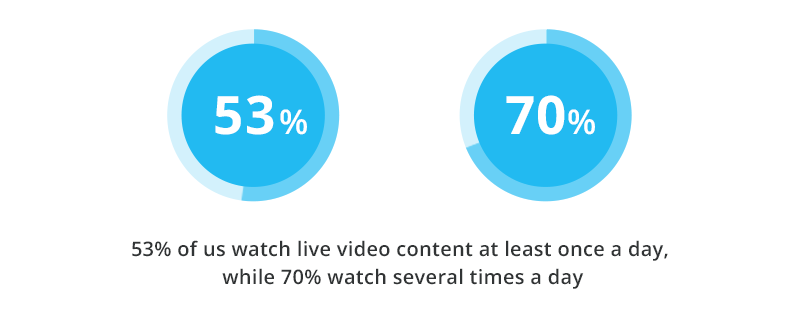
The report also makes a strong point that video streaming is still growing rapidly. Forty-seven per cent of people who took part in the IAB survey said that they stream more videos in 2018 than they did a year ago. Russians are a model example of what the report calls the ‘video thirsty user’, as 61% of Russian respondents said they watch more streams now than a year ago.
How we watch content
Out of all of our web-connected devices, smartphones are the most popular when it comes to watching video streams (for 62% of survey respondents). In second place comes the PC/laptop, while tablets come third. The reports notes that the most popular ways to watch video streams is further reflected in the devices people keep at home, as listed below.
“What device I own or have access to”:
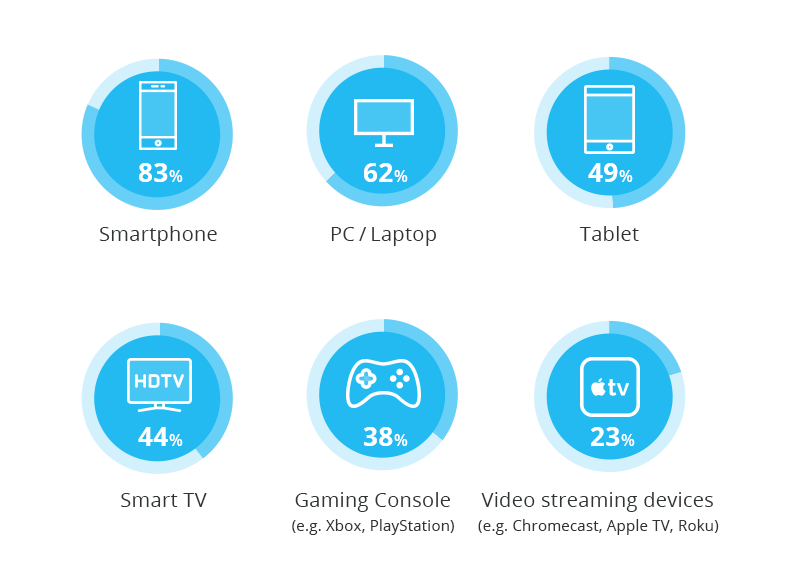
The ever-present smartphone is noted as the device on which we watch live video content most frequently – 67% of respondents use them at least once a day or several times a day. In terms of use, the second device is a Smart TV, while tablets and video streaming devices (Chromecast, Apple TV) come joint third.
However, while we might use smartphones to watch live video content most often, the report concludes that the device is not the best platform for longer formats.
It seems that audiences around the world prefer to watch long formats, or videos for longer periods of time, on bigger screens. The Smart TV comes top with 67% watching more than 30 minutes of live streams daily; while video streaming devices (that are connected to and watched through a TV) follow closely behind on 62%. Only in 47% of cases are smartphones used to watch video for 30 minutes or more.
Audiences prefer to watch longer video content on bigger screens, while smartphones are often used for short videos no longer than 10-30 minutes in length.
Where we consume content
Social media now plays a key role in many areas of life. Unsurprisingly, viewers like to watch live streams mostly on social media (52%), with dedicated, digital streaming platforms with subscriptions coming in second place (41%).
The report highlights that social platforms are a natural place for streaming and probably one of the best places for viewing:
- (Almost) everyone can access social media streams, as long as they have a web connection.
- Social media is free to use.
- Social channels are widely accessible via almost any web-enabled device you can imagine: PCs, smartphones, tablets, Smart TVs, gaming consoles etc.
- Social offers specific features that help broadcasters to promote and inform users about a stream.
- Users also benefit from specific features, such as the ability to chat during a stream.
Digital streaming subscription platforms, like Hulu Live or DirectTV Now, are dedicated to digital entertainment and offer access to multiple TV channels using a connected device. Users can watch anywhere, either live or on-demand at a more convenient time.
Other, popular sources of live video streams are:
- TV network websites or apps (like ITV Hub, All4 or other web services that provide live streams from traditional TV broadcasters) – 34%
- Gaming websites or apps – 33%
- Paid TV service provider website or app – 21%
- Other sources – 9%
Content we like to consume
The most popular type of content that is streamed by digital viewers around the world is the TV series (for 45% of users).
Thirty-one per cent watch live sports, with 30% tuning into how-to tutorials. Gaming fans represent 29% of live video content consumers. What’s interesting is that live videos made by friends or family members are appealing to 28%; while news is interesting for 27%, videos made by an online celebrity or influencer for 24%, live concerts for 23% and talk shows for 22%.

There isn’t anything too surprising about the above types of content we like to consume. For most people, a box-set TV serial is the go-to content across the web in general, including video on-demand (VOD) and live streaming services. Live sports events are then an obvious second, as sport is all about being ‘in the moment’.
Where we consume
Gone are the days of a TV set in every room, probably forever. Live content is now everywhere, across laptops, smartphones and tablets to name just a few. These new screens are often the first thing we look at in the morning and, quite probably, the last thing we look at before going to sleep.
According to the IAB report, 73% of live video content is consumed at home. Outdoor consumption appears to be alongside journeys and social events, like going to a restaurant, bar or the park, or on the way to work and while shopping.

Thirty-seven per cent of viewers spend 81% or more of their time live streaming in the company of others, which increases to 56% of viewers when using a smartphone. This is worth remembering, as it means that up to just over half of your streaming audience will be more than one person, depending on the device being used.
How we multi-task while watching live streams
While watching live streams an audience’s attention is highly distracted. But this doesn’t mean that they don’t pay attention to what they see on the screen. In fact, while they will do other things, these are more often related to what is being watched.
Things (related to what is being watched) that viewers do while watching live content:
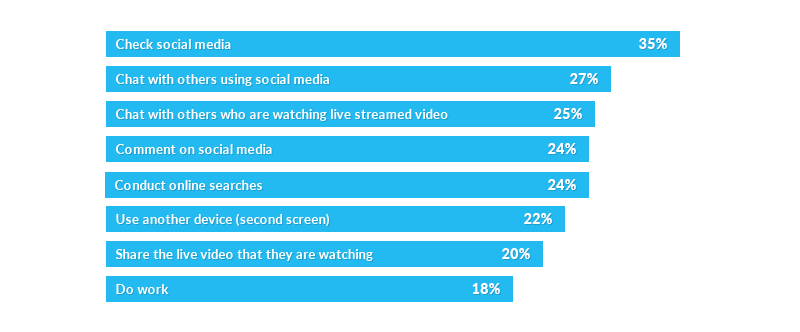
Why we watch live streams
So, what exactly does an audience look for in a live stream? The IAB report asked respondents – What are the main reasons for you to watch live video streaming content? – and the responses shed light on why we watch:
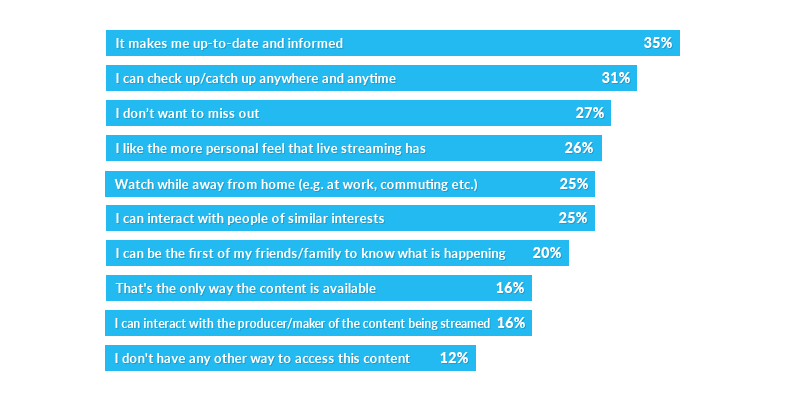
Something that should be of valuable insight to many live content industry professionals, the report also asked: Which of the following factors influence your choice of live video streaming sources?
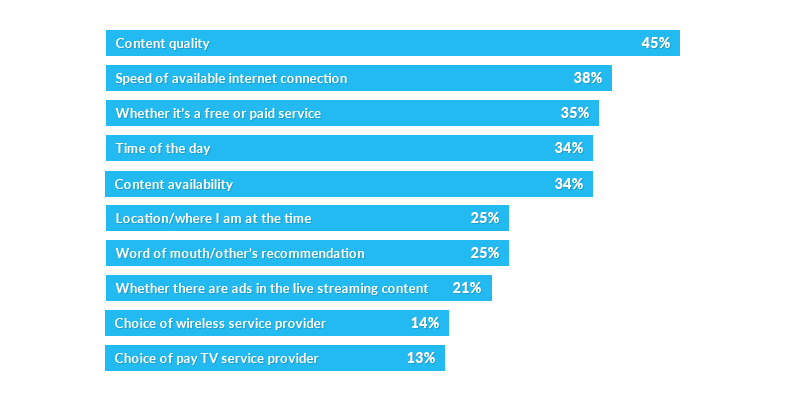
It seems that technical aspects, such as content quality and the speed of connection, are crucial here, while ads (or the absence of ads) in a live stream are not so important after all.
Key takeaways about the live video consumer
Based on the IAB report’s survey results, if we were to create a persona for the ‘live video content consumer’, the following would form their habits and thoughts. They would:
- Watch live video content a couple of times a day
- Own a smartphone and use it to stream live video content
- View streams via social media channels
- Favour TV serials and sports
- Enjoy watching live streams in the late evening – from 8pm to 11pm
- Check social media and look for related online content while watching a stream
- Appreciate content quality and connection speed
- Like how live content makes them feel up to date and well informed
Although the above makes some pretty big generalisations, once you start to glean new insights from reports such as the IAB’s, then you can build a better picture of the live video content consumer. Worth remembering!
Reaching the live video streaming consumer
When it comes to execution of your live video strategy and getting the tools to reach the live video consumer described above, simply try one of our Tellyo solutions. Tellyo Pro is for regular, extensive broadcasts; while Tellyo On Demand is designed for more occasional use. If you’re not sure which solution would suit you, please get in contact and the team here will be more than happy to help.
Will the real host of the 2022 FIFA World Cup be the web?
With massive stadiums, world-wide federations and leagues, and global superstars, Football is undoubtedly the most important sport in the world. Its popularity spans the globe, while the quadrennial FIFA World Cup is always a huge spectacle that goes beyond sport. It’s a game of fame, money and status, and a coming together of different cultures and styles.
The world’s eyes are all on the tournament in Russia right now. The event is being beamed and streamed to every corner of the globe. And thanks to TV infrastructure and extensive internet access, fans can watch games in all sorts of places – from pubs and fan zones to Mongolian yurts and even small, remote islands on the Pacific.
Check out our other stories:
- Ideas for online video content when you can’t show games
- The most common live video streaming habits of digital audiences
- Still looking for a prime alternative to Snappy TV?
But how is our viewing changing and what will this look like for the next World Cup in Qatar 2022?
How we watched the 2014 World Cup
During the 2014 World Cup held in Brazil, an estimated 280 million people watched matches online or on a mobile device, according to official FIFA data[1].
As the rights owner, FIFA reached 207 territories with its content (the definition of ‘territory’ being a bit wider than a “country”). The final was watched by approximately 695 million viewers at home (calculated as people who watched at least 20 consecutive minutes in their own home). However, the final figure was surely higher, as many viewers will have watched in their favourite bar or in specially prepared fan zones. Yet it was still a 12% growth when compared to the 2010 World Cup in South Africa.
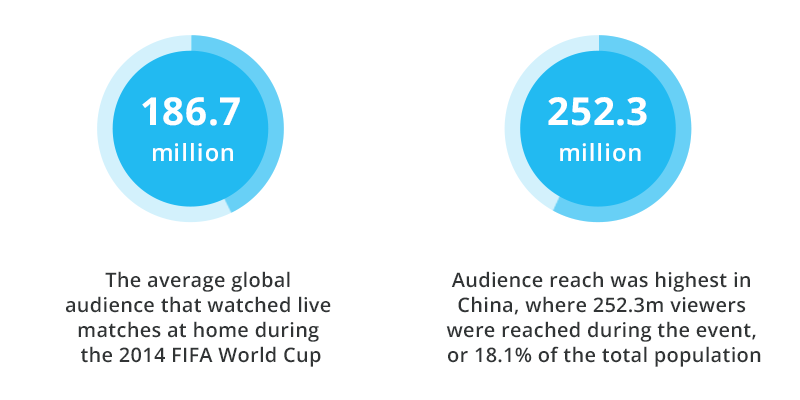
According to FIFA, there was more online coverage in 2014 than any previous World Cup tournament, with 188 licensees offering coverage via websites, media players and apps.
What’s more, since 2014 consumer surveys suggest that online TV viewing is up by 36%, while mobile TV viewing has increased by 248%. Obviously these viewing figures have been boosted by technological developments, increased broadband penetration, better devices, and faster internet speeds in all regions.
It seems that the better the infrastructure, the better the online video reach. But credit also has to go to the progressive strategies of many TV stations. With the World Cup proving so popular, national broadcasters continue to show it for free, with no extra charges. Many are committed to making content easily accessible and widely distributed by catering to all viewing habits – from traditional TV to online and mobile.
If not for free, many countries also offer lots of options to pay for access to content beyond a national TV station.
How will people watch the 2018 World Cup?
To see the detailed results of World Cup viewership we will have to wait until the end of the tournament. But with a huge dose of certainty – and some early indicators so far – we can predict that results are going to show a record high when it comes to online video content.
While TV is still the king of sports broadcasts, online live streams are fast gaining traction.

Released just before the 2018 World Cup got underway, a recent IAB report – Live Video Streaming: A Global Perspective – provides us with a better picture.
What’s really interesting is the number of different media platforms that will be used during the 2018 World Cup.
The IAB report asked:
Which, if any, of the following media channels and devices do you plan to use to watch/follow the 2018 FIFA World Cup?
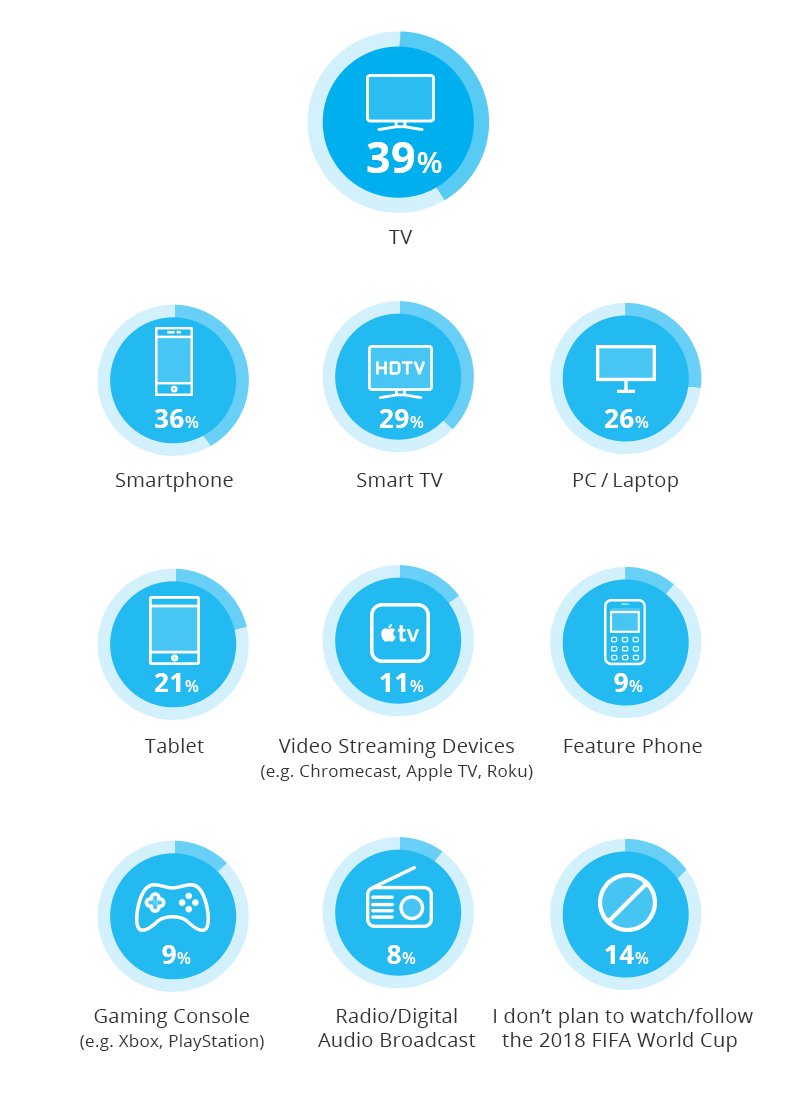
When taking a closer look at the above list, what’s noticeable is that most of the devices will need an internet connection to access World Cup video content such as games.
It gets even more interesting if we go further and look at those answers from geographical regions. According to the report, smartphones are the most popular option (45%) for watching World Cup games in the APAC region (Australia and China), while South Americans prefer TV (49%).
Looking ahead to 2022
It’s a bit too early to write any final conclusions about how we watched this year’s World Cup. But looking at data from 2014 and the available audience insights prior to the tournament in Russia, it looks like online access will be at a record high regardless of the device or platform being used to watch content. Perhaps the 2018 FIFA World Cup will prove a breakthrough for online broadcasters. If so, surely the 2022 tournament will be even more wireless and web focused. It’s time to go online!
[2] Live Video Streaming – A Global Perspective – IAB Report, June 2018
Tellyo selected finalist SXSW accelerator pitch event
We are proud to share that we were selected as a finalist in the Sports and Performance Data Technologies category for the 10th annual SXSW Accelerator Pitch Event®.
The SXSW Accelerator is the marquee event of South by Southwest® (SXSW®) Conference & Festivals (March 9-18, 2018) Startup & Tech Sectors Track, where leading startups from around the world showcase some of the most impressive technology innovations to a panel of hand-picked judges and a live audience. Out of the more than 600 companies that applied to present at SXSW Accelerator, Tellyo was selected among the 50 finalists spanning 10 separate categories.
The two-day event will be held the first weekend of SXSW Conference & Festivals, Saturday, March 10 and Sunday, March 11, on the third floor of the Downtown Hilton Austin, Salon A/B. The Pitch Event will then culminate with the SXSW Accelerator Awards Ceremony on Sunday evening, March 11, where winning startups from each category and a Best in Show winner will be announced and honored.
The Accelerator will feature finalists across the following 10 categories: Augmented & Virtual Reality, Enterprise & Smart Data, Entertainment & Content, Health & Wearables, Hyper-Connected Communities, Payment & FinTech, Security & Privacy, Social & Culture, Sports & Performance Data, and Transportation.
Tellyo will present among four other companies in the Sports and Performance Data Technologies category on Sunday 11 March 2018.
Richard Collins, Tellyo CEO, said: “We’re excited to be shortlisted for the highly prestigious SXSW Accelerator Pitch Event and honored to be sharing the stage with other leading-edge technology innovators. At the event in March, we look forward to showcasing our cloud-based video production platform, and how it helps our customers to amplify live sports events and engage with fans more effectively online.”
Tellyo’s cloud-based video production platform gives sports broadcasters and rights holders the solutions they need to easily create engaging videos from live content, and share them to social and digital channels in real-time. The company has partnerships with the International Table Tennis Federation, Guinness PRO14 Rugby, broadcaster Polsat, sports television producer Sunset+Vine, extreme sports event organiser FISE, and British Cycling.
“For the past decade, we’ve had the honor of offering a platform to some of the most cutting-edge global technologies and innovations – allowing CEOs and developers to present their solutions to investors, potential partners and key targets,” said SXSW Accelerator Event Producer Chris Valentine. “Of those who’ve presented on stage, over 70% have gone on to receive funding in excess of nearly $4.63 billion. In addition, 16% of these companies went on to be acquired. We look forward to once again being a launching pad for startups to achieve some of their greatest successes. All of us with SXSW Accelerator are proud and impressed by the companies who are truly changing industries and changing the world.”
For more information about SXSW Accelerator and to view the complete list of finalists, visit: http://www.sxsw.com/interactive/awards/accelerator.
About SXSW
SXSW dedicates itself to helping creative people achieve their goals. Founded in 1987 in Austin, Texas, SXSW is best known for its conference and festivals that celebrate the convergence of the interactive, film, and music industries. The event, an essential destination for global professionals, features sessions, showcases, screenings, exhibitions, and a variety of networking opportunities. SXSW proves that the most unexpected discoveries happen when diverse topics and people come together. SXSW 2018 will take place March 9-18, 2018.
Your essential read if you’ve ever wondered how to make traditional TV cool again!
In the US, adults are spending more and more time with different kinds of digital media[1], while their attention is also shifting from traditional TV to PCs, and smartphones and tablets connected to the web.
What’s interesting is that while there is an enormous variety of traditionally broadcast TV channels to choose from (a monthly average of 206 channels according to Nielsen research), US adults only actively watch 20 of them[2]. In other Nielsen data for US adults, while TV still rules people are using a broader range of devices for home entertainment, with apps and the web now hot on the heels of TV. The total time spent on other devices now outweighs time spent watching traditional TV.
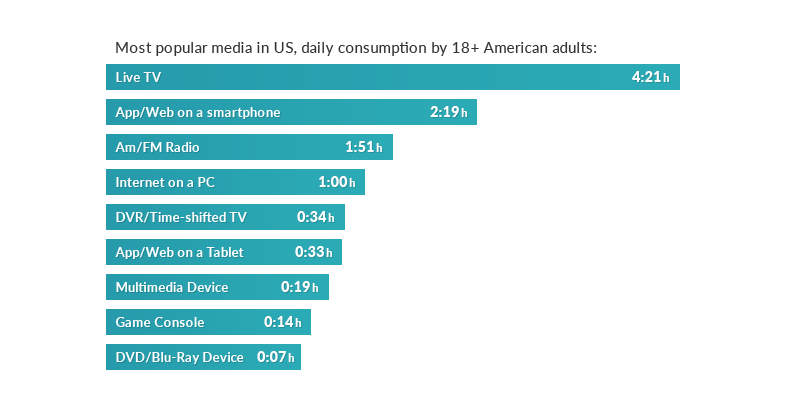
If you look at the behaviour of younger viewers in particular, what’s evident is that Generation Z (12-20 year olds) consume the smallest amount of traditional TV, either when live or time shifted/recorded. Arguably, this is the effect of a new and younger audience becoming bored (or simply not accustomed to) traditional TV’s linear approach, which might be a challenging argument to accept if you work in broadcast TV.
To help you to understand, let’s look at this analogy. Nowadays, traditional TV is like a middle-aged guy trying to gain popularity on Snapchat – the technology feels the same, the rules are clear, but somehow it simply doesn’t work for him. What he says and does is simply not attractive enough for the audience on that platform. (Believe me, I feel like this guy at times as I don’t always understand the buzz surrounding Snapchat.)
Back in the broadcasting world, you may be more than conscious that new ways of consuming media are coming. You might feel they’re already here. Yet, with huge resources, varied schedules and all the broadcasting technology at your disposal, perhaps you’re still left wondering why traditional TV isn’t as attractive as it was? Perhaps you can’t quite put your finger on why this is the case.
Let’s take a closer look at some of the opportunities and threats below.
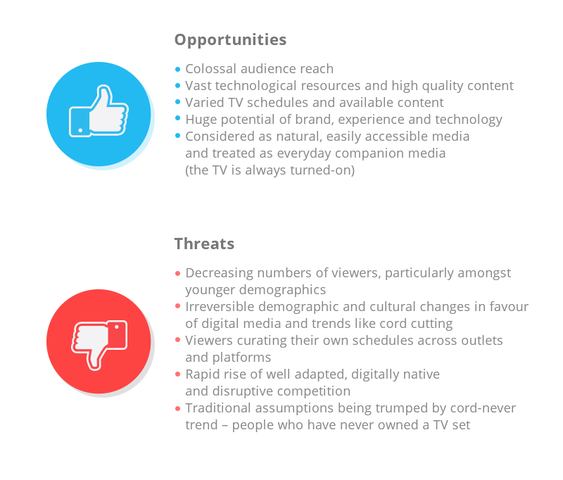
What’s common amongst the above threats is the impact of the internet and the smartphone. Viewers now have more flexibility – they can watch and interact with digital, web TV and OTTs in any manner they like, where and when they want, and on the device of their choosing.
Why should viewers miss the ol’ set-top box? So, is this the end of linear TV as we know it? It’s too early to jump to this kind of conclusion. For sure, there are now many more options to traditional TV and improvements that linear broadcasters should make to stay in the game.
Let’s dive in and check out six ways you can sharpen your focus to stay alive in this fast-paced, digital-first world.
- Make the web your friend and ally
- Use your TV brand as leverage
- Your experience is your advantage
- Retain your loyal viewers
- Work across platforms
- Conversations – it takes (at least) two to tango!
First things first, if you haven’t done so already, make your brand more visible online by expanding your social media presence. Take time to reconsider your options, making an audit of your efforts to date to identify what’s worked and what hasn’t.
When relaunching your social media presence, have a video content strategy in place that puts you in a position to start streaming and producing videos for social channels. Streams and social videos make for highly engaging web content and, as a broadcaster, you are ideally placed to create a constant stream of such content. To do so, choose social video production tools and platforms that will fit your needs, and ones that will enable you to stream and produce videos from live content and any archival content you want to use.

Live streams and videos are undoubtedly the most engaging types of content. When checking Facebook streaming results for one of our Tellyo clients, we learned that it is possible to create up to 400 interactions per 1,000 fans with live video, while images were able to reach only 6 interactions per 1,000. For further interesting stats, check out the case studies section on our website.
Having a strong and recognisable brand is unbelievably helpful online – it will help you to stand out. If your logo is well known, you should remember to place it on your video content, so that when this spreads around the internet you get the brand recognition you deserve. With a little bit of luck, many viewers will trace your quality content back to your channel or Facebook page.
Being experienced with video production and everything broadcasting related is a huge advantage over your competitors. Being able to create TV-grade video content, while having an experienced team and professional equipment are all strong assets. However, these assets aren’t enough to be successful on the web and in the social media, but they will help a lot. You can always talk to us here at Tellyo about how to combine your experience with an advanced, social video production platform such as ours.
Have you ever heard of the Pareto principle[4]? Better known as the 80/20 rule which states that 80% of the effects come from 20% of the causes. Translating this into broadcast language – it means that 20% of your audience is responsible for 80% of your views. Therefore, if you want to be successful in social media, play to your core audience. Let them know that soon they will be able to watch their favourite shows and events via other media as well.
Remember that social media isn’t monolithic – it’s decentralised and each platform has its own properties. You shouldn’t copy and paste your strategy from one channel to another. For example, if you decide to stream content then use YouTube, Facebook or Twitter, but only YouTube will be a good place as a platform to host clips for a longer period. Facebook will give you a big audience and visibility initially, but people will not find your videos once they vanish from timelines.
Your audience has a voice, and it will use it. In comments, emails and chats, they will use each possible channel to give you their opinion about your content. And that’s a good thing – a gold mine of interactions and engagement to treasure. You should work hard to maintain these conversations. Be active: answer questions and ask for opinions.
It’s too early to abandon ship
Traditional, linear TV still has a lot to offer audiences. But the TV landscape in the next 5-10 years will be dramatically different to what we have now.
In the meantime, there is likely to be many more advances and disruptive changes. Now is your chance to decide whether you want to be part of it or not.
Everything you’d like to know about video streaming, but were afraid to ask
If you are just about to start your adventure with professional live video streaming, you may well be a little bit confused. Whether you’re a social media specialist or digital marketer or you’re working in sport, fashion or the music business, streaming will undoubtedly improve your content, brand visibility and boost sales. But there’s a plethora of things you need to remember, learn and tons of options to choose from. Let’s start with the basics and answer some of the most commonly asked questions regarding live video streaming.
What are the best ways to livestream an event and why?
There are many free solutions if you want to stream an event, which you can easily check out for yourself. For personal use, the free solutions can be great. But if you aspire to professional streaming of any kind, the free options aren’t going to offer you enough.
Free software solutions for live video streaming (whether an online or desktop solution) are either not advanced enough or simply not good enough. When using a free solution it is quite common to encounter problems during a livestream and highly likely you will not be able to get support when it comes to technical issues.
If you aim to create great live streamed content and promote your event effectively, you should put in place specialist software that will enable you to better configure and manage your stream.
Professional quality never comes for free!
In answering the question, to stream your event in the best possible way, use professional tools to guarantee great results.
What is the best software for live video streaming?
Here at Tellyo, we’ve put a lot of expertise into creating our streaming software. We’re confident it is one of the best professional solutions for streaming regardless of the event type – be it a sports match, fashion show or music gig. Why?
Specifically designed for streaming and clipping videos, our software platform enables you to edit your content and its audio, and adjust videos to fit different formats and streaming destinations (such as Facebook and YouTube).
Tellyo is cloud-based software built on a core platform that delivers two separate solutions to choose from: Tellyo Pro for extensive usage when you have lots to live stream; plus Tellyo On Demand for occasional streams and when you want no strings and simple payments. Both are fully professional solutions and support the most popular social media channels like Facebook, YouTube, Twitter, and Periscope.
You can request Tellyo Pro demo here (we will require some technical details from you) or simply create your account in Tellyo On Demand and start streaming.
What are some of the best live video broadcasting sites to stream live events?
If you want to stream to social media using a channel that’s already popular in the market, there are quite a few streaming-friendly sites we can highlight:
- YouTube
- Periscope
What’s great about the above platforms is that they not only offer streaming features, but also include other cool features too, like chat (YouTube) or announcements and sponsored posts (Facebook). However, the most important part of the deal is that popular social media channels offer direct contact with audiences on pre-established platforms.
Is it possible to live stream to Facebook, YouTube and Twitter simultaneously?
Yes. You can stream to all of the above mentioned platforms simultaneously using Tellyo. Additionally, you can broadcast to other, custom RTMP destinations.
What are some KPIs for live streaming?
This will very much depend on your strategic objectives. If you wish to gain audience and brand visibility, you should aim to get as many viewers and views as possible. Total reach is also a valuable indicator because it shows how many people could have potentially viewed your content.
Depending on your needs, other indicators might include engagement signals (likes, comments and shares), leads and sales, or new signups to on-demand platforms.
It is crucial to set some goals before you start a stream, as these will give you something to measure against.
What are the best practices for live streaming events?
We’ve prepared a number of articles that you might find useful, regardless of your streaming experience or industry knowledge:
- Improve your social broadcasts with different content types
- 8 common live streaming mistakes
- What indicates success? The social video KPIs that count
- Going social with your broadcast: the basics
- Sports video content ideas to help you survive out of season
- How to prepare and promo live-streamed sports content?
- How to incorporate sponsorship into your real-time social videos
- How to turn broadcast content into great social live streams
- Three ways to maximise real-time interactions with fans
- Understanding the power of online sports videos
- A sport marketer’s simple guide to Facebook post promotion
Explore our blog for other interesting insights and ideas.
Is it possible to clip videos out of a live stream?
Using Tellyo – yes. Our platform allows you to cut clips out of live streams and simultaneously share them on social media in a matter of seconds. You can enhance your clips using our feature-packed Editor or simply clip-and-publish. Videos can be distributed straight from the Editor to the most popular social platforms of your choice. If video editing and live streaming is your main concern – consider using Tellyo.
What kind of events can be turned into live video streams?
There’s really no correct answer to this. However, if you’re responsible for an event and it would benefit from having a larger audience, or you want to reach people who are unable to attend in person, then it would be a good option to stream.
To understand what kind of events others are streaming, let’s take a look at some of our clients:
Our Tellyo Pro is used mainly by sports leagues and federations, and TV and digital broadcasters. They will own content or have the rights to stream it, so they require a trusted service that will enable them to broadcast their content directly to social media. They stream big amounts of content regularly, such as entire matches and complete shows.
Tellyo On Demand is used across sport, fashion, music and event organising. It offers a more flexible option and is suitable for organisations who only need to stream from time to time, but still want to rely on an excellent service. They stream small amounts of content, such as occasional behind-the-scenes footage, gigs, press conferences, and fashion shows.
Still not convinced?
If you still have some doubts regarding live video streaming, live production, real time video sharing or anything in between – let us know. Send in your question(s) using our form, message us at contact@tellyo.com, or make contact via social media.







